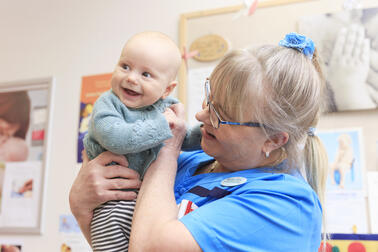
Over the course of the year, we served millions of Helsinki residents through our services. Client feedback was positive: the net promoter score based on their ratings was a strong 64 – a clear improvement from the previous year.
Staff feedback was also encouraging, with 79% of employees recommending us as an employer. Our strengths include meaningful work and well-functioning work communities. Employees particularly appreciate fair treatment from their immediate supervisors and rated our coaching leadership highly.
Here are some examples of the encounters our clients and employees had in 2024:
- 3,659,000 home care visits
- 1,582,500 housing days in long-term 24-hour care for older people
- 1,375,200 appointments with health station nurses
- 875,000 appointments with health station doctors
- 480,650 visits to dental clinics
- 795,000 housing days in housing services for mental health clients
- 743,400 housing days in housing services for unhoused people
- 306,000 housing days in enhanced service housing in disability services
- 296,500 visits to maternity and child health clinics
- 273,000 appointments with psychiatric outpatient services
- 18,400 adult social work clients
- 8,000 emergency responses by the Rescue Department and 53,000 emergency medical service assignments
- 24.7 million client contacts via the Maisa client portal
In 2024, we also opened several new service locations, including the Helsinki Diabetes Centre, Mieppi City Centre, Kontula Rescue Station and the Siltamäki unit in disability services for clients needing demanding multidisciplinary support. We introduced new service models such as family care for older people and a digital model for monitoring gestational diabetes. We cleared the backlog in oral health care, improved mental health services for young people, and strengthened school and student health care. The Mobile Nurse service helped reduce EMS calls and emergency department visits among older people.
Transformation programme delivering results
“Safeguarding the wellbeing, health and safety of Helsinki residents is our core mission. We are committed to maintaining services in all circumstances, despite financial pressures. We have worked hard to develop health, social and rescue services in Helsinki, while also keeping costs under control,” says Juha Jolkkonen, Head of Division.
2024 was a financially challenging year. We pushed forward with our transformation programme, which has already helped us adjust our finances by approximately EUR 70 million. We optimised the use of premises by giving up underused office spaces, reduced reliance on temporary agency workers, raised client fees to align with national levels, and introduced financial training for all staff.
Client experience and resident needs guide service development
The client experience played an increasingly central role in service development. We collect client feedback continuously, and in October 2024, we conducted an open survey to gather residents’ views on health and social services.
Key priorities for respondents included service quality, affordability and swift access. People also wanted services to be conveniently located near their homes. Smooth services mean being able to take care of multiple matters in one place and interact with familiar professionals. Many respondents also hoped for evening appointment options.
The most valued contact channels were the Maisa client portal and phone calls. Half of the respondents preferred using digital channels when an in-person visit wasn’t necessary, while the other half always preferred face-to-face service. Many called for clearer digital channels.
"We will continue to ensure that the client and resident experience is strongly reflected in our services. It will shape our future service strategy and be visible in our service points, website and digital services,” says Juha Jolkkonen.


